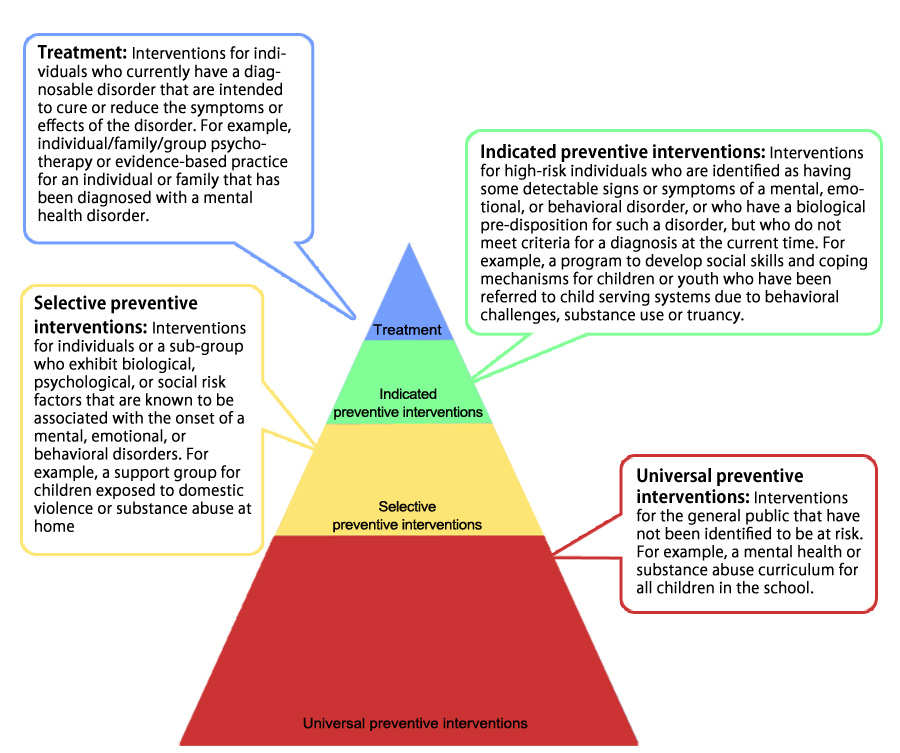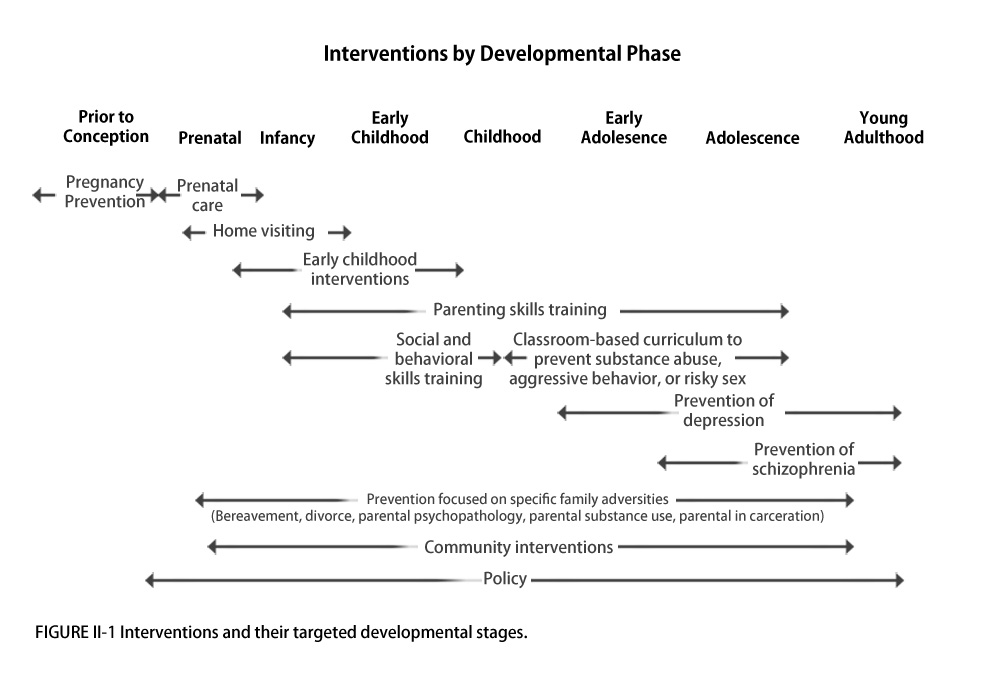Youth who receive special education services under the Individuals with Disabilities Education Act (IDEA 2004) and especially young adults of transition age, should be involved in planning for life after high school as early as possible and no later than age 16. Transition services should stem from the individual youth’s needs and strengths, ensuring that planning takes into account his or her interests, preferences, and desires for the future.
Mental Health Promotion and Prevention
The terms mental health promotion and prevention have often been confused. Promotion is defined as intervening to optimize positive mental health by addressing determinants of positive mental health before a specific mental health problem has been identified, with the ultimate goal of improving the positive mental health of the population. Mental health prevention is defined as intervening to minimize mental health problems by addressing determinants of mental health problems before a specific mental health problem has been identified in the individual, group, or population of focus with the ultimate goal of reducing the number of future mental health problems in the population.1 Mental health promotion and prevention are at the core of a public health approach to children and youth mental health which addresses the mental health of all children, focusing on the balance of optimizing positive mental health as well as preventing and treating mental health problems.
Promotion
Mental health promotion attempts to encourage and increase protective factors and healthy behaviors that can help prevent the onset of a diagnosable mental disorder and reduce risk factors that can lead to the development of a mental disorder.2 It also involves creating living conditions and environments that support mental health and allow people to adopt and maintain healthy lifestyles or a “a climate that respects and protects basic civil, political, socio-economic and cultural rights is fundamental to mental health promotion. Without the security and freedom provided by these rights, it is very difficult to maintain a high level of mental health.”3
Specifically, mental health can be promoted through
- early childhood interventions (e.g., home visits for pregnant women, pre-school psychosocial activities);
- providing support for children (e.g., skills building programs, child and youth development programs);
- programs targeted at vulnerable groups, including minorities, indigenous people, migrants, and people affected by conflicts and disasters (e.g., psychosocial interventions after disasters);
- incorporating mental health promotional activities in schools (e.g., programs supporting ecological changes in schools and child-friendly schools);
- violence prevention programs; and, among others,
- community development programs.4
Positive youth development is defined by the Interagency Working Group on Youth Programs as an intentional, pro-social approach that
- engages youth within their communities, schools, organizations, peer groups, and families in a manner that is productive and constructive;
- recognizes, utilizes, and enhances youths' strengths; and
- promotes positive outcomes for young people by providing opportunities, fostering positive relationships, and furnishing the support needed to build on their leadership strengths.
It provides a lens for promoting the mental health of youth by focusing on protective factors in a young person's environment, and on how these factors could influence one's ability to overcome adversity. Learn more about positive youth development.
Prevention
Prevention efforts can vary based on the, audience they are addressing, level of intensity they are providing, and the development phase they target. Figure 1 depicts the different types of prevention as defined by the Institute of Medicine. As prevention efforts move from universal prevention interventions to treatment they increase in intensity and become more individualized.
Figure 1: Levels of Intervention5
Note: Click the image to Enlarge.
Interventions may vary not only based on level of intensity, as seen in Figure 1, but also on the development phase of the youth. Figure 2 provides examples of preventive interventions for each of the developmental stages through young adulthood.
Figure 2: Preventive Interventions by Developmental Phase6
Note: Click the image to Enlarge.
Resources
NEW! Youth Social Media Use and Mental Health: Tip Sheet for Adults Who Work with Youth (PDF, 2 pages)
This resource provides a discussion on the current state of youth, social media, and mental health. It also provides tips on how to support and partner with youth who are active on social media. This tip sheet was informed by youth, researchers, and federal staff who attended the Interagency Working Group on Youth Programs’ Social Media and Youth Mental Health meeting at the Substance Abuse and Mental Health Services Administration on July 11, 2019.
Preventing Mental, Emotional, and Behavioral Disorders Among Youth People: Progress and Possibilities
From the National Academy Press, this document explores prevention practices in a variety of settings, including programs for selected at-risk populations (such as children and youth in the child welfare system), school-based interventions, interventions in primary care settings, and community services designed to address a broad array of mental health needs and populations.
Guideposts for Success for Youth with Mental Health Needs
The Guideposts for Success are a framework to assist the multiple organizations that need to be involved to meet the needs and improve the transition outcomes of all youth, including youth with disabilities. The guideposts discuss school-based services, career preparation, leadership opportunities, community services, and family involvement supports for youth with mental health needs. These documents were developed by the National Collaborative on Workforce and Disability which is supported by funds from the Department of Labor.
Positive Mental Health
The Office of Adolescent Health provides a range of information on mental health including a section focused on positive mental health and how to promote resilience. Visit the site to learn more about this topic and other mental health information for adolescents.
Systematic Review and Meta-Analysis: Effectiveness of Wraparound Care Coordination for Children and Adolescents
“Wraparound” has been adopted to better meet the mental health and other needs of young people with serious emotional and behavioral needs and their families, and keep them safely in their homes and communities. However, it has long been debated whether Wraparound is actually more effective than traditional services. New research from the University of Washington finds that Wraparound consistently produces more positive outcomes for these youth. Wraparound may also hold potential for reducing disparities in outcomes for youth of color, disparities that have long been found for mental health services.
References
1 Miles, Espiritu, Horen, Sebian, & Waetzig, 2010
2 WHO, 2010
3 WHO, 2010
4 Substance Abuse and Mental Health Services Administration, National Registry of Evidence-based Programs and Practices, 2012
5 O’Connell, Boat, & Warner, 2009, p. 66
6 O’Connell, Boat, & Warner, 2009, p. 155
Other Resources on this Topic
Agencies
Announcements
Collaboration Profiles
Data Sources
Departments
Feature Articles
Hotlines
Programs
Publications
Resources
Technical Assistance
Tools & Guides
Training Resources
Videos & Podcasts
Webinars & Presentations
Websites
Youth Topics
Youth Briefs
Research links early leadership with increased self-efficacy and suggests that leadership can help youth to develop decision making and interpersonal skills that support successes in the workforce and adulthood. In addition, young leaders tend to be more involved in their communities, and have lower dropout rates than their peers. Youth leaders also show considerable benefits for their communities, providing valuable insight into the needs and interests of young people
Statistics reflecting the number of youth suffering from mental health, substance abuse, and co-occurring disorders highlight the necessity for schools, families, support staff, and communities to work together to develop targeted, coordinated, and comprehensive transition plans for young people with a history of mental health needs and/or substance abuse.
Nearly 30,000 youth aged out of foster care in Fiscal Year 2009, which represents nine percent of the young people involved in the foster care system that year. This transition can be challenging for youth, especially youth who have grown up in the child welfare system.
Research has demonstrated that as many as one in five children/youth have a diagnosable mental health disorder. Read about how coordination between public service agencies can improve treatment for these youth.
Civic engagement has the potential to empower young adults, increase their self-determination, and give them the skills and self-confidence they need to enter the workforce. Read about one youth’s experience in AmeriCorps National Civilian Community Corps (NCCC).








